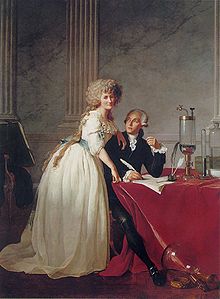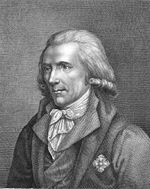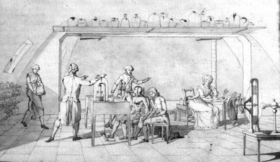- Marie-Anne Pierrette Paulze
-
 Portrait of M. and Mme Lavoisier, by Jacques-Louis David, 1788 (Metropolitan Museum)
Portrait of M. and Mme Lavoisier, by Jacques-Louis David, 1788 (Metropolitan Museum)
Marie-Anne Pierette Paulze (20 January 1758 – 10 February 1836), was a French chemist. She was born in the town of Montbrison, Loire, in a small province in France. She is most commonly known as the spouse of Antoine Lavoisier (Madame Lavoisier) but many do not know of her accomplishments in the field of chemistry: she acted as the laboratory assistant of her spouse and contributed to his work.
Contents
Background
Her father, Jacques Paulze, was of French descent and worked primarily as a parliamentary lawyer and financier. Most of his income came from running the Ferme Générale (The General Farm) which was a private consortium of financiers who paid the French monarchy for the privilege of collecting certain taxes. Her mother, Claudine Thoynet Paulze, died in 1761, leaving behind not only Marie-Anne but two other sons. After her mother’s death Marie-Anne was placed in a convent where she received her formal education.
At the age of thirteen Marie-Anne received a marriage proposal from the Count d’Amerval, who was nearly three times her age. Jacques Paulze tried to object to the union, but received threats about losing his job with the Ferme Générale. To indirectly thwart the marriage, Jacque Paulze made an offer to one of his colleagues to ask for his daughter’s hand instead. This colleague was Antoine Lavoisier, a French nobleman and scientist. Lavoisier accepted the proposition, and he and Marie-Anne were married on 16 December 1771. Lavoisier was about 28.
Lavoisier continued to work for the Ferme-Générale but in 1775 was appointed gunpowder administrator, leading the couple to settle down at the Arsenal in Paris. Here, Lavoisier’s interest in chemistry blossomed, and, with the financial security provided by both his and Marie-Anne’s family, as well as his various titles and other business ventures, he was able to construct a state-of-the-art chemistry laboratory. Marie-Anne soon became interested in his scientific research and began to actively participate in his laboratory work.
As her interest developed, she received formal training in the field from Jean-Baptiste Bucquet and Philippe Gingembre, both of whom were Lavoisier’s colleagues at the time. The Lavoisiers spent most of their time together in the laboratory, working as a team conducting research on many fronts. In fact, the majority of the research effort put forth in the laboratory was actually a joint effort between Marie-Anne and her husband, with Marie-Anne mainly playing the role of laboratory assistant.
French Revolution
In 1794 Lavoisier, due to his prominent position in the Ferme-Générale, was branded a traitor during the Reign of Terror by French revolutionaries. Marie-Anne’s father, another prominent Ferme-Générale member, was arrested on similar grounds. On 28 November 1793 Lavoisier surrendered to revolutionaries and was imprisoned at Port-Libre. Throughout his imprisonment Marie-Anne visited Lavoisier regularly and fought for his release. She presented his case before Antoine Dupin, who was Lavoisier’s accuser and a former member of the Ferme-Générale. She told of her husband’s accomplishments as a scientist and his importance to the nation of France. Despite her efforts Lavoisier was tried, convicted of treason and executed on 8 May 1794 in Paris, at the age of 50. Jacques Paulze, Marie-Anne’s father, was also executed on the same day.
After his death Marie-Anne became bitter about what had happened to her husband. She was thrown into bankruptcy following the new government's confiscation of her money and property. In addition, the new government seized all of Lavoisier’s notebooks and laboratory equipment. Despite these obstacles, Marie-Anne organized the publication of Lavoisier’s final memoirs, Mémoires de Chimie, a compilation of his papers and those of his colleagues demonstrating the principles of the new chemistry. The first volume contained work on heat and the formation of liquids, while the second dealt with the ideas of combustion, air, calcination of metals, action of acids, and the composition of water. In the original copy Marie-Anne wrote the preface and attacked revolutionaries and Lavoisier’s contemporaries, whom she believed to be responsible for his death. This preface, however, was not included in the final publication. Nevertheless, her efforts secured her husband's legacy in the field of chemistry.
Benjamin Thompson
Marie-Anne eventually remarried, following a four-year courtship and engagement to Benjamin Thompson (Count Rumford). Rumford was one of the most well-known physicists at the time, but the marriage between the two was difficult and short-lived. Marie-Anne also insisted throughout her life that she retain the last name of her first husband, demonstrating her undying devotion to him. Marie-Anne died suddenly in her home in Paris on 10 February 1836, at the age of 78.
Contributions to chemistry
Marie-Anne accompanied Lavoisier in his lab during the day, making entries into his lab notebooks and sketching diagrams of his experimental designs. The training she had received from the painter Jacques-Louis David allowed her to accurately and precisely draw experimental apparatuses, which ultimately helped many of Lavoisier’s contemporaries to understand his methods and results. Furthermore, she served as the editor of his reports. Together, the Lavoisiers rebuilt the field of chemistry, which had its roots in alchemy and at the time was a convoluted science dominated by George Stahl’s theory of phlogiston.
In the eighteenth century the idea of phlogiston (a fire-like element which is gained or released during a material’s combustion) was used to describe the apparent property changes that substances exhibited when burned. Marie-Anne, being a master in the English, Latin, and French languages, was able to translate various works about phlogiston into French for her husband to read. Perhaps her most important translation was that of Richard Kirwan's essay 'Essay on Phlogiston and the Constitution of Acids' (see google books), which she both translated and critiqued, adding footnotes as she went along and pointing out errors in the chemistry made throughout the paper. She also translated works by Joseph Priestley, Henry Cavendish, and others for Lavoisier’s personal use. This was an invaluable service to Lavoisier, who relied on Marie-Anne’s translation of foreign works to keep abreast of current developments in chemistry. In the case of phlogiston, it was Marie-Anne’s translation that convinced him the idea was incorrect, ultimately leading to his studies of combustion and his discovery of oxygen gas.
Marie-Anne was also instrumental in the 1789 publication of Lavoisier’s Elementary Treatise on Chemistry, which presented a unified view of chemistry as a field. This work proved pivotal in the progression of chemistry, as it presented the idea of conservation of mass as well as a list of elements and a new system for chemical nomenclature. Marie-Anne contributed thirteen drawings that showed all the laboratory instrumentation and equipment used by the Lavoisiers in their experiments. She also kept strict records of the procedures followed, lending validity to the findings Lavoisier published.
Accomplishments as a historian
Before her death, Marie-Anne was able to recover nearly all of Lavoisier’s notebooks and chemical apparatuses, most of which survive in a collection at Cornell University, the largest of its kind outside of Europe.
References
- Bell, Madison Smartt. Lavoisier in the Year One. New York: Atlas Books, 2005.
- Borgias, Adriane P. “Marie Anne Pierrette Paulze Lavoisier.” Women in Chemistry and Physics, A Biobibliographic Sourcebook. Eds. Louise S. Grinstein, Rose K Rose, and Miriam H. Rafailovich. Connecticut: Greenwood Press, 1993: 314-319.
- Crawford, Franklin. “CU’s great treasure of science: Lavoisier collection is Mme. Lavoisier’s Achievement.” Cornell Chronicle [New York]. 30 Jan. 2007. 12 Apr. 2007. <http://www.news.cornell.edu/stories/Jan07/Lavoisier.html>.
- Eagle, Cassandra T. and Sloan, Jennifer. “Marie Anne Paulze Lavoisier: The Mother of Modern Chemistry.” The Chemical Educator 3.5 (1998): 1-18. 12 Apr. 2007 <http://www.springerlink.com/content/x14v35m5n8822v42/fulltext.pdf>
- Hoffmann, R., "Mme Lavoisier", American Scientist 90 (Jan-Feb, 2002) pp. 22-24. Bell, Madison Smartt. Lavoisier in the Year One. New York: Atlas Books, 2005.
- Rayner-Canham, Geoffrey and Marelene. “Marie Anna Pierrette Paulze Lavoisier.” Women in Chemistry. Massachusetts: American Chemical Society and Chemical Heritage Foundation, 1998: 17-22.
External links
- "Marie Lavoisier". John H. Lienhard. The Engines of Our Ingenuity. NPR. KUHF-FM Houston. 2002. No. 1673. Transcript. The transcript page includes Marie Lavoisier's engraving of a gazometer, from Traité Élémentaire de Chimie.
Categories:- 1758 births
- 1836 deaths
- People from Montbrison, Loire
- French chemists
- Women chemists
- English–French translators
- Latin–French translators
Wikimedia Foundation. 2010.


